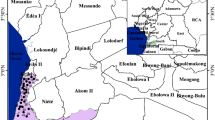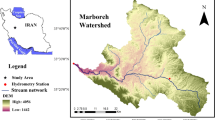Abstract
In this paper, Crude Monte Carlo method and importance sampling are utilized to determine the reliability of long-term changes in groundwater level. Furthermore, different data analysis methods are used to determine the abnormal patterns and to investigate the cause of spatial variations of failure probability. For this purpose, three methods including robust covariance, one-class SVM, and Isolation Forest are applied to define the decision function. In the preliminary detection of the outliers, DFFITS and COOK measures are used to confirm the existence of abnormal plains in a two-dimensional space. The validity of prediction results is verified through the developed method of uncertain monitoring by selecting the most significant outlier points. In addition, the abnormal pattern detection methods are compared using non-random pattern discovery decision functions. The reliability analysis of groundwater is conducted during the two periods from 1994 to 2007 and 2008 to 2021. In the second period, parts of the eastern part of the northwest, central parts of the desert of Iran, and areas from west-southwest and east-south-east to other regions exposed to a lower probability of passing through the critical conditions. In contrast, the outcomes confirm the occurrence of drought with probability more than 80% for most of the plains. Eventually, the importance sampling method showed the closest relation in the correct distribution of the decision function. In contrast, due to the cluster shape and density of the outliers, the upper part of the decision function was determined with high certainty in the discovery of abnormal plains.















Similar content being viewed by others
References
Bobba AG, Singh VP, Bengtsson L (1996) Application of first-order and Monte Carlo analysis in watershed water quality models. Water Resour Manag 10:219–240
Bouderbala A, Remini B, Saaed Hamoudi A, Pulido-Bosch A (2016) Application of multivariate statistical techniques for characterization of groundwater quality in the coastal aquifer of Nador, Tipaza (Algeria). Acta Geophys 64:670–693
Bowles M (2015) Machine learning in Python: essential techniques for predictive analysis, 1st edn. John Wiley & Sons Ltd, Chichester
Chaudhary A, Hantush MM (2017) Bayesian Monte Carlo and maximum likelihood approach for uncertainty estimation and risk management: application to lake oxygen recovery model. Water Res 108:301–311
Chopra M, Rastogi R, Kumar AV, Sunny F, Nair R (2013) Response surface method coupled with first-order reliability method based methodology for groundwater flow and contaminant transport model for the uranium tailings pond site. Environ Model Assess 18:439–450
Ditlevsen O, Madsen HO (1996) Structural reliability methods. Wiley, New York
Faber MH (2007) Risk and safety in civil engineering. Lecture notes. Swiss Federal Institute of Technology, Zurich
Gupta R, Bhave PR (1994) Reliability analysis of water-distribution systems. J Environ Eng 120:447–461
Hackl J (2013) Generic framework for stochastic modeling of reinforced concrete deterioration caused by corrosion. Master’s thesis, Norwegian University of Science and Technology, Department of Structural Engineering, Trondheim, August 2013
Jeong J, Park E, Han WS, Kim K-Y (2017a) A subagging regression method for estimating the qualitative and quantitative state of groundwater. Hydrogeol J 25:1–10
Jeong J, Park E, Han WS, Kim K, Choung S, Chung IM (2017b) Identifying outliers of non-Gaussian groundwater state data based on ensemble estimation for long-term trends. J Hydrol 548:135–144
Lee C-M, Hamm S-Y, Jeon H-T, Kim M, Kim H-K, Kim K (2017) Water policy of Korea for supplying safe groundwater in rural areas. Water 9:508
Legchenko A, Comte J-C, Ofterdinger U, Vouillamoz J-M, Lawson FMA, Walsh J (2017) Joint use of singular value decomposition and Monte-Carlo simulation for estimating uncertainty in surface NMR inversion. J Appl Geophys 144:28–36
Lemaire M (2009) Structural reliability. ISTE Ltd, London and John Wiley and Sons, New York
Malioka V (2009) Condition indicators for the assessment of local and spatial deterioration of concrete structures. Ph.D. thesis, Swiss Federal Institute of Technology Zurich
Nolz R, Loiskandl W (2017) Evaluating soil water content data monitored at different locations in a vineyard with regard to irrigation control. Soil & Water Research 12(3):152–160
Nowak AS, Collins KR (2012) Reliability of structures, 2nd edn. CRC Press, Taylor and Francis group, New York
Rahman S, Hossain F (2008) Spatial assessment of water quality in peripheral rivers of Dhaka City for optimal relocation of water intake point. Water Resour Manag 22:377–391
Schölkopf B, Platt JC, Shawe-Taylor J, Smola AJ, Williamson RC (2001) Estimating the support of a high-dimensional distribution. Neural Comput 13:1443–1471
Thorndahl S, Willems P (2008) Probabilistic modelling of overflow, surcharge and flooding in urban drainage using the first-order reliability method and parameterization of local rain series. Water Res 42:455–466
Ward AS, Kelleher CA, Mason SJ, Wagener T, Mcintyre N, Mcglynn B, Runkel RL, Payn RA (2017) A software tool to assess uncertainty in transient-storage model parameters using Monte Carlo simulations. Freshwat Sci 36:195–217
Zaltsberg E (1982) Application of statistical methods to forecasting of natural groundwater tables. Can J Earth Sci 19:1486–1491
Zohrevand, Z., Glasser, U., Shahir, H. Y., Tayebi, M. A. & Costanzo, R (2016) Hidden Markov based anomaly detection for water supply systems. Big Data (Big Data), 2016 IEEE International Conference on, 2016. IEEE, 1551–1560
Funding
There is no funding information to be disclosed in this manuscript.
Author information
Authors and Affiliations
Corresponding author
Ethics declarations
Disclosure Statement
No potential conflict of interests was reported by the authors.
Rights and permissions
About this article
Cite this article
Azimi, S., Azhdary Moghaddam, M. & Hashemi Monfared, S.A. Anomaly Detection and Reliability Analysis of Groundwater by Crude Monte Carlo and Importance Sampling Approaches. Water Resour Manage 32, 4447–4467 (2018). https://doi.org/10.1007/s11269-018-2029-y
Received:
Accepted:
Published:
Issue Date:
DOI: https://doi.org/10.1007/s11269-018-2029-y




